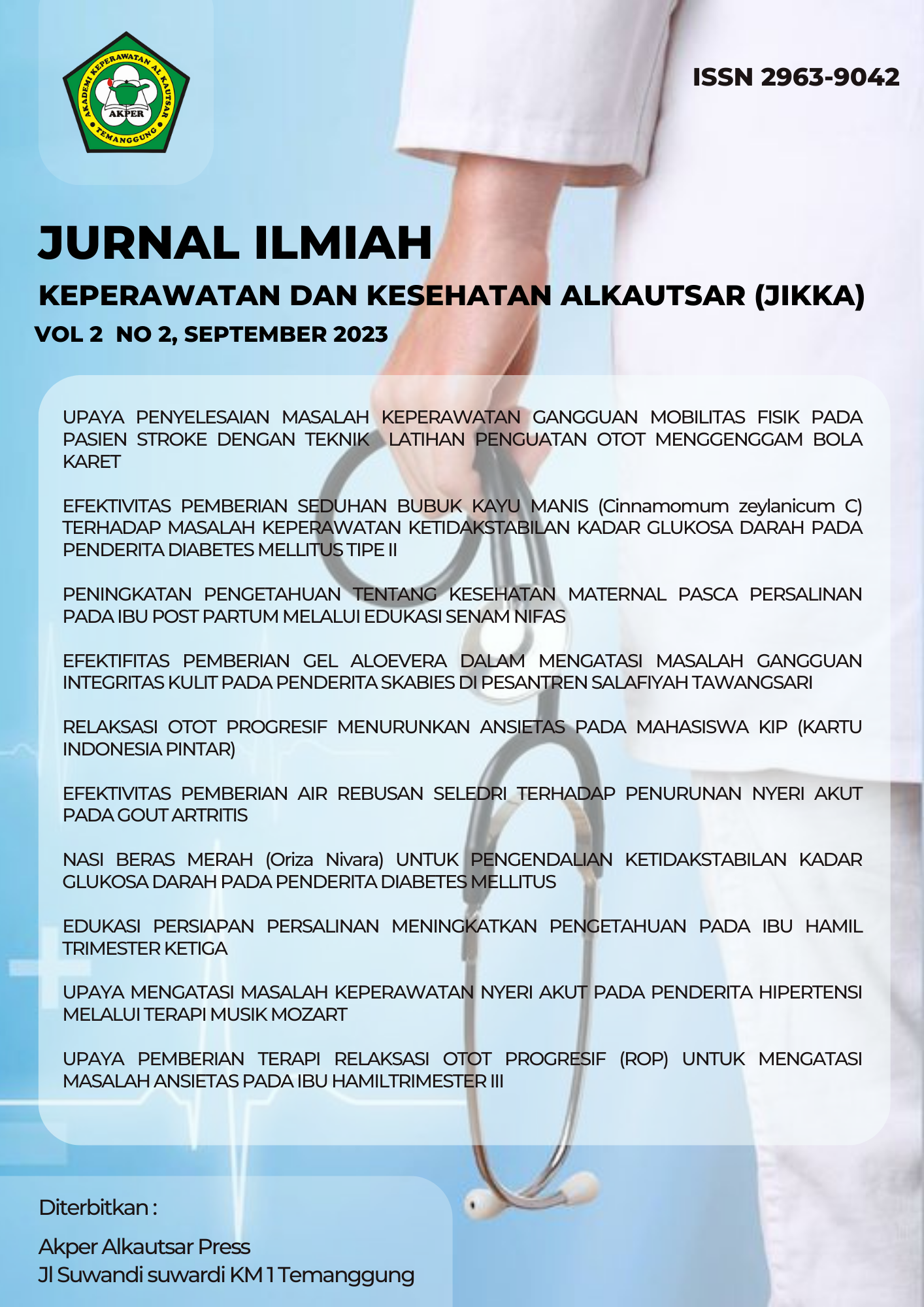EFFORTS TO SOLVE THE PROBLEM OF INTERFERENCE NURSING PHYSICAL MOBILITY IN STROKE PATIENTS WITH MUSCLE STRENGTHENING TRAINING TECHNIQUES HOLD THE RUBBER BALL
DOI:
https://doi.org/10.64314/jikka.v2i1.77Keywords:
Impaired Physical Mobility, Holding a Rubber Ball, StrokeAbstract
Background: Stroke is a condition where there is a disturbance of brain function caused by blockage of blood vessels or rupture of blood vessels, resulting in a lack or absence of oxygen supply to brain tissue and causing neurological damage. One of the effects of blood vessel blockage is a decrease in the ability to function motorically or experience impaired physical mobility. One of the signs of impaired physical mobility is a decrease in muscle strength in the upper extremities. The function main of the upper extremity as a tool of movement. If decreased muscle strength is not treated, it will result in the main function of the upper extremities not working properly and limited mobility in carrying out daily activities. The nursing action to overcome physical mobility disorders is to do muscle strengthening exercises, especially in the upper extremities, while holding a rubber ball. Purpose: of this research is to describe how the act of strengthening the muscles by gripping a rubber ball can help solve the problem of impaired physical mobility in stroke patients. Data collection was obtained from interviews and observations of the two case study subjects who had a stroke with impaired physical mobility with a value of muscle strength less than equal to 3. Results of the study after the action was carried out two times in seven days, there was an increase in muscle strength from before the action, when the value of muscle strength was 2 to 4 in subject 1, and 1 to 4 in subject 2. Rubber ball gripping exercises can used as one of the actions to overcome impaired physical mobility in stroke.References
Ana, E., & Sutarni, S. (2018). Sinkop Pada Pasien Stroke Vertebrobasiler. Berkala Ilmiah Kedokteran Duta Wacana, 3(1), 38. https://doi.org/10.21460/bikdw.v3i1.82
Azizah, N., & Wahyuningsih. (2020). Genggam Bola Untuk Mengatasi Hambatan Mobilitas Fisik Pada Pasien Stroke Nonhemoragik. Jurnal Manajemen Asuhan Keperawatan, 4(1), 35–42. https://doi.org/10.33655/mak.v4i1.80
Diskominfo. (2021). Temanggung Regency Statistics in 2021. In Temanggung Regency Communication and Information Office.
Farida, U., Sukariman, & Kuati, S. (2018). Pengaruh ROM Exercise Bola Karet Terhadap Kekuatan Otot Genggam Pasien Stroke Di RSUD RAA Soewondo Pati. Indonesia Jurnal Perawat, 3(1), 36–43.
Hayati, H., & Sutarni, S. (2020). Laporan Kasus: Vertigo Pada Pasien Stroke Iskemik Vertebrobasiler Dan Syok Hipovolemi. Callosum Neurology, 3(2), 54–57. https://doi.org/10.29342/cnj.v3i2.110
Huda, N., & Muflihan, S. K. (2018). Analysis of Clinical Nursing Practice at the Client with the Stroke of a Non Hemoragik (Snh) and Facial Massage and Innovation Interventions Facial Expression Facial Symmetry Against Stroke Patients with Face Dropping at the Stroke Center AFI of Abdul Wah. 1(1), 1–8. http://dx.doi.org/10.1016/j.cirp.2016.06.001%0Ahttp://dx.doi.org/10.1016/j.powtec.2016.12.055%0Ahttps://doi.org/10.1016/j.ijfatigue.2019.02.006%0Ahttps://doi.org/10.1016/j.matlet.2019.04.024%0Ahttps://doi.org/10.1016/j.matlet.2019.127252%0Ahttp://dx.doi.o
Kusuma, A. P., Utami, I. T., & Purwono, J. (2022). Pengaruh Terapi “Menggengam Bola Karet Bergerigi” Terhadap Perubahan Kekuatan Otot Pada Pasien Stroke Diukur Menggunakan Hangryp Dynamometer Di Ruang Syaraf Rsud Jend a Yani Kota Metro the Effect of “Greeting Rubber Ball” Therapy on Changes in Muscle Stre. Jurnal Cendikia Muda, 2(1).
Margiyati, Rahmanti, A., & Prasetyo, E. D. (2022). Penerapan Latihan Genggam Bola Karet Terhadap Kekuatan Otot Pada Klien Stroke Non Hemoragik. 4(1).
Nurmufthi, G. Y. (2014). Dysarthria Post Stroke Attack With Uncontrolled Hypertension and Obesity on a Hpusewife. J Agromed Unila, 1(2), 104–108.
PPNI. (2017). Diagnosa Keperawatan Indonesia. Definisi dan Indikator Diagnostik Keperawatan (Edisi 1). DPP PPNI.
Riskesdas. (2018). Laporan Provinsi Jawa Tengah Riskesdas 2018. In Kementerian Kesehatan RI.
Saputra, D. G., Dewi, N. R., & Ayubana, S. (2022). Penerapan Terapi Menggenggam Bola Karet Terhadap Perubahan Kekuatan Otot Pada Pasien Stroke Dengan Hemiparase Di Kota Metro. Jurnal Cendikia Muda, 2(September), 308–312.
Sari, M. N. (2018). “Skeletal Muscle: Structure and Function" (Otot Rangka: Struktur Dan Fungsi)". Jurnal Manajemen Sains, 199–221.
Solution, H. H. (2011). Stroke di Usia Muda. PT Gramedia.
Sundoro, B. T. (2020). Pola Tutur Penderita Cadel Dan Penyebabnya (Kajian Psikolinguistik). KREDO : Jurnal Ilmiah Bahasa Dan Sastra, 3(2), 338–349. https://doi.org/10.24176/kredo.v3i2.4612
Tini, R. M., & Surya, A. (2021). Hubungan Subtipe Stroke Dengan Angka Kejadian Demensia Pada Pasien Pasca Stroke Di RSUD Deli Serdang. Jurnal Pandu Husada, 2(1), 15. https://doi.org/10.30596/jph.v2i1.5385
Widodo, H. (2019). Memahami Sistem Saraf (H. Rahayu (ed.)). Mutiara Anksara.





.png)



